Terraform it: Terragenesis review
You can find a variety of games in the App Store / Google Play, so I was not very surprised when I was asked in one of the profile chats if I knew a game about terraforming celestial bodies. After watching it, I decided to write a short review, because the game, in my opinion, although not without flaws, is curious enough.

The game can be downloaded for free, the creators earn on advertising and scripts, so only the planets of the earth group are available at no extra cost, of which only Mars is first discovered. Terraforming issues of Mars are often raised, so this is an appropriate option.
Starting a new game. First they suggest choosing a fraction. Each has its own bonuses and penalties, but in general, the choice does not really matter, so choose what you like best.

The complexity of “For Experts” differs from “Normal” only in the number of bad events: “the level of the building has dropped”, “a meteorite is flying, allocate money or lose the building”, etc., this is more annoying than adding interest, so I advise “Normal” . And in the "Ecosystem" section, I highly recommend choosing the "Biosphere" mode, this is almost a game in the game, and it is much more interesting with it.

The main window, the still lifeless Mars rotates below. The player has enough of the usual tasks for urban development strategies - we extract resources, research and build buildings.
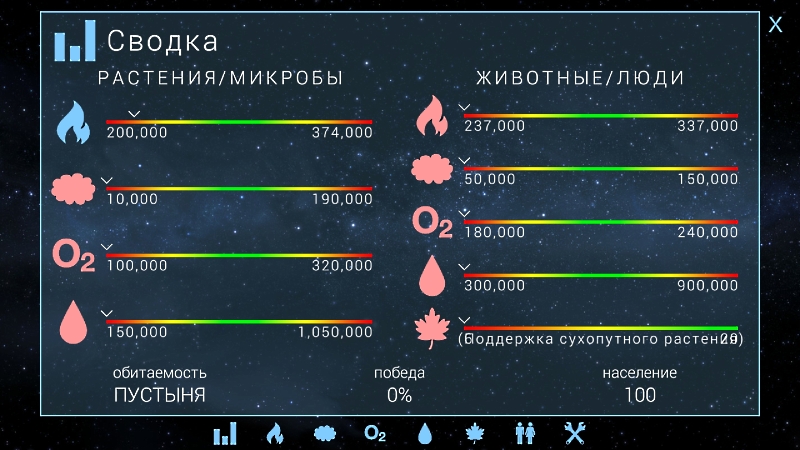
Window of the state of the planet. In order to make a flowering garden from Mars, it is necessary to raise the temperature and pressure, increase the oxygen content, add water. All parameters are made at a fairly simple level. For example, the water level is measured in centimeters, and buildings that add or remove water also change it in centimeters, not taking into account the surface topography. Also, the composition of the atmosphere or the distribution of climatic zones is not taken into account. This leads to anecdotal situations where, for example, in the scenario with the Moon, the temperature is considered normal, although without the atmosphere there on the day side up to + 127 ° С, and on the night side up to -190 ° С.

We start with the construction of the first colony. When choosing a place, do not forget that seas will appear on Mars, and buildings in the lowlands will be flooded. Personally, I was insolently located on Mount Olympus, and the colony was called "Ski Resort."

A colony cannot be imagined without a source of funding. And the main income will first come from the mines. The picture is looking for a place for them. The choice of resources involuntarily makes you smile - if the most expensive palladium and rhodium are truly valuable and logical, then it’s at least strange to mine silver, iron or carbon on Mars and sell it on Earth. The possibility of researching the extraction of more expensive resources is not tied to the population or the achieved level of terraforming, which looks like a flaw in the game design, because you can explore the most profitable mines already for 2-3 days of the game. Involuntarily recalling complex chains and tuned balance in the games of the Anno series.
Hint: In order for you not to have problems with money, it is enough to follow a simple algorithm:
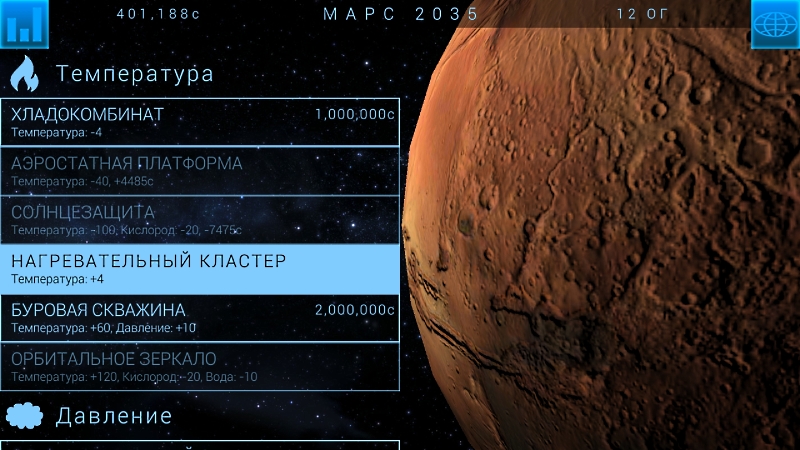
When the money problems are resolved, it's time to do terraforming. It is organized simply: each parameter has three-level buildings that increase or decrease it. Buildings have descriptions that are much more popular than scientific. And the explanatory text of the first level cooler, at least in the Russian version, looks like a violation of the second law of thermodynamics - some designs generate electricity, while cooling the planet. In reality, there are heat pumps that transfer heat from a cold source to a heated consumer, but they consume electricity, rather than generate. However, there are quite realistic concepts like orbital mirrors or bombardment of the celestial body with comets.

I am glad that the creators correctly assessed the scale of work on terraforming - a noticeable atmosphere on Mars appears after several hundred years.

A few centuries later, water fills the lowlands. The picture is beautiful, this cannot be taken away.
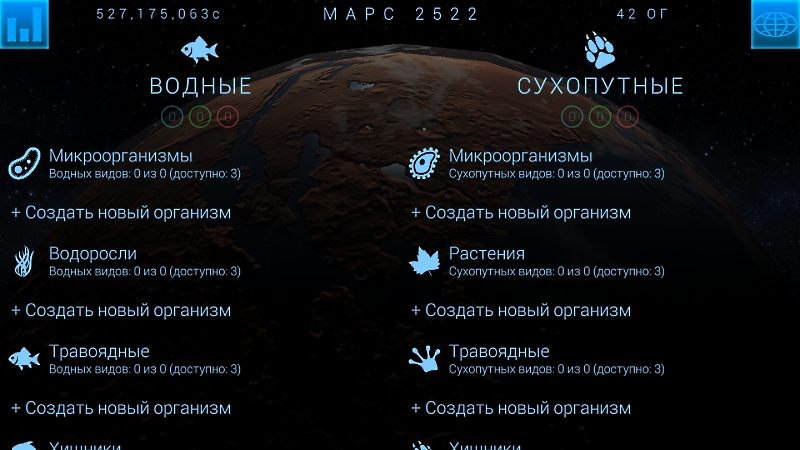
When the conditions become suitable, the most interesting thing begins - the settlement of life. Using a fairly simple example, the game explains what an environmental pyramid is. This is realized through the concept of support - each organism at its level produces "support", consumed by the next level. Three levels allow you to build a pyramid of microorganisms-plants-herbivores-predators.
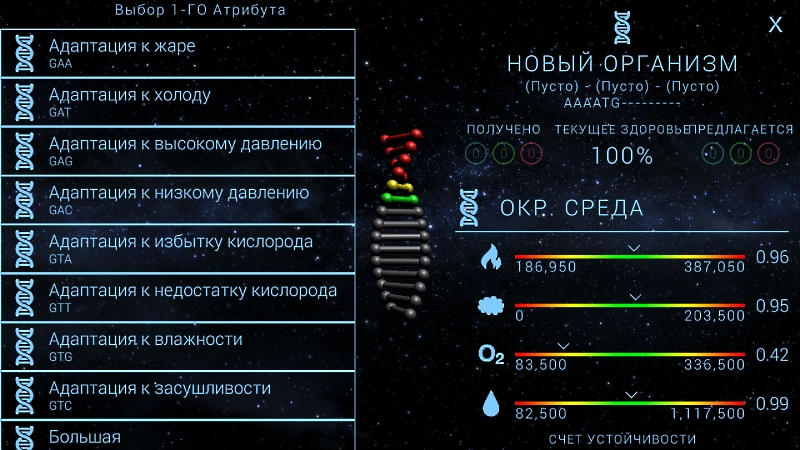
A simple interface for designing organisms allows you to create suitable for the environment. You can also create organisms that change conditions on the planet in addition to buildings or generate income. There is no problem with money at this stage for a long time, but it is the biosphere that can become the main source of income. And the interconnection of levels leads to the fact that an error or an accidental event can trigger a chain reaction, which will need to be disintegrated for a long time.
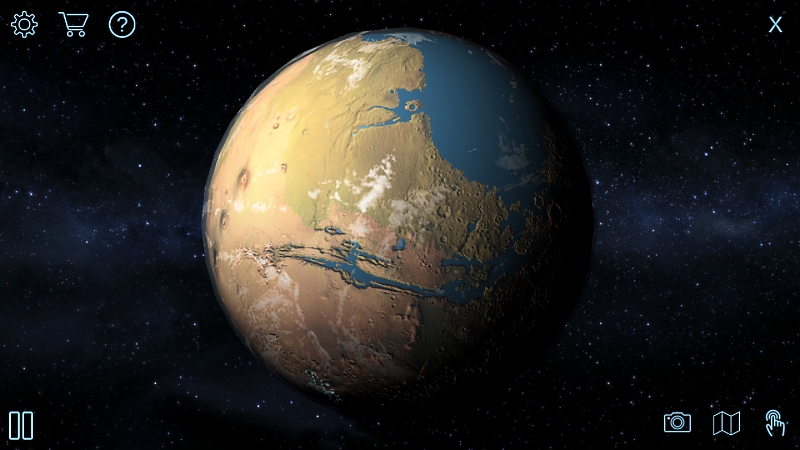
When the biosphere spreads across the planet, the picture becomes even more pleasing to the eye. Mars of the 27th century is a comfortable place where you can run through the grass, eat an apple and stroke a beautiful Martian hyena (almost all of Mars' flora and fauna is beautiful, therefore it is traded throughout the solar system, and I chose the scavenger attribute for predators so that the colonists don’t ate alive).
The last stage is cultural independence. Culture points are issued for population growth and random events; it is not difficult to accumulate them.
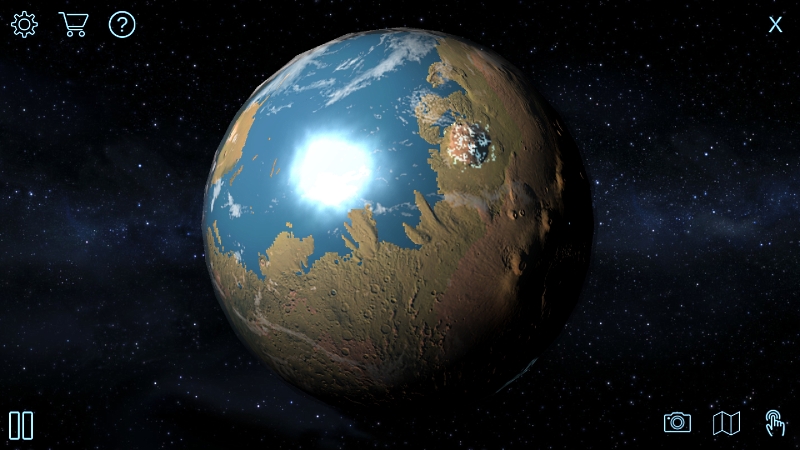
Around the mountain Olympus the lights of a big city are burning - the population is already more than a million. The party is won.
Personally, I would like to see a more realistic terraforming. For example, for temperature: thermal energy comes from the Sun, is released from the bowels of the planet and is created by buildings. In the atmosphere, the greenhouse effect retains heat, while other substances, on the contrary, reflect sunlight. Also, heat is constantly radiated into outer space. And the player’s task would be to balance the production and radiation (loss) of heat. And the simplifications of physics in the game reduce not only interest, but also replayability - on Mars we build buildings that raise pressure, on Venus - we lower, but the sensations from it are the same.
The advantages of the game, I would attribute simplicity and beauty. It’s nice to look at how the planet is changing. Implementing an informative and interesting project is simultaneously difficult, so the Terragenesis developers sacrificed a scientific part and put fun and simplicity at the forefront, so the game is more suitable for children than hardcore geeks.
PS In early May, a big update came out, now the picture is even more beautiful.

The game can be downloaded for free, the creators earn on advertising and scripts, so only the planets of the earth group are available at no extra cost, of which only Mars is first discovered. Terraforming issues of Mars are often raised, so this is an appropriate option.
Starting a new game. First they suggest choosing a fraction. Each has its own bonuses and penalties, but in general, the choice does not really matter, so choose what you like best.

The complexity of “For Experts” differs from “Normal” only in the number of bad events: “the level of the building has dropped”, “a meteorite is flying, allocate money or lose the building”, etc., this is more annoying than adding interest, so I advise “Normal” . And in the "Ecosystem" section, I highly recommend choosing the "Biosphere" mode, this is almost a game in the game, and it is much more interesting with it.

The main window, the still lifeless Mars rotates below. The player has enough of the usual tasks for urban development strategies - we extract resources, research and build buildings.

Window of the state of the planet. In order to make a flowering garden from Mars, it is necessary to raise the temperature and pressure, increase the oxygen content, add water. All parameters are made at a fairly simple level. For example, the water level is measured in centimeters, and buildings that add or remove water also change it in centimeters, not taking into account the surface topography. Also, the composition of the atmosphere or the distribution of climatic zones is not taken into account. This leads to anecdotal situations where, for example, in the scenario with the Moon, the temperature is considered normal, although without the atmosphere there on the day side up to + 127 ° С, and on the night side up to -190 ° С.

We start with the construction of the first colony. When choosing a place, do not forget that seas will appear on Mars, and buildings in the lowlands will be flooded. Personally, I was insolently located on Mount Olympus, and the colony was called "Ski Resort."

A colony cannot be imagined without a source of funding. And the main income will first come from the mines. The picture is looking for a place for them. The choice of resources involuntarily makes you smile - if the most expensive palladium and rhodium are truly valuable and logical, then it’s at least strange to mine silver, iron or carbon on Mars and sell it on Earth. The possibility of researching the extraction of more expensive resources is not tied to the population or the achieved level of terraforming, which looks like a flaw in the game design, because you can explore the most profitable mines already for 2-3 days of the game. Involuntarily recalling complex chains and tuned balance in the games of the Anno series.
Hint: In order for you not to have problems with money, it is enough to follow a simple algorithm:
Under the spoiler instructions for those who do not want to learn on their own
- The initial resources will be enough to study iron production (level 2) and build an outpost with 9 mines.
- (Optional) we watch advertising, it doubles the income from production.
- After a day, the extracted resources will be enough to build two colonies and two outposts.
- Outposts earn money directly, and the two colonies will start generating events “talented X appeared in colony Y” and “the inhabitants of the colonies established transport links between themselves”, which create sources of additional money.

When the money problems are resolved, it's time to do terraforming. It is organized simply: each parameter has three-level buildings that increase or decrease it. Buildings have descriptions that are much more popular than scientific. And the explanatory text of the first level cooler, at least in the Russian version, looks like a violation of the second law of thermodynamics - some designs generate electricity, while cooling the planet. In reality, there are heat pumps that transfer heat from a cold source to a heated consumer, but they consume electricity, rather than generate. However, there are quite realistic concepts like orbital mirrors or bombardment of the celestial body with comets.

I am glad that the creators correctly assessed the scale of work on terraforming - a noticeable atmosphere on Mars appears after several hundred years.

A few centuries later, water fills the lowlands. The picture is beautiful, this cannot be taken away.

When the conditions become suitable, the most interesting thing begins - the settlement of life. Using a fairly simple example, the game explains what an environmental pyramid is. This is realized through the concept of support - each organism at its level produces "support", consumed by the next level. Three levels allow you to build a pyramid of microorganisms-plants-herbivores-predators.

A simple interface for designing organisms allows you to create suitable for the environment. You can also create organisms that change conditions on the planet in addition to buildings or generate income. There is no problem with money at this stage for a long time, but it is the biosphere that can become the main source of income. And the interconnection of levels leads to the fact that an error or an accidental event can trigger a chain reaction, which will need to be disintegrated for a long time.

When the biosphere spreads across the planet, the picture becomes even more pleasing to the eye. Mars of the 27th century is a comfortable place where you can run through the grass, eat an apple and stroke a beautiful Martian hyena (almost all of Mars' flora and fauna is beautiful, therefore it is traded throughout the solar system, and I chose the scavenger attribute for predators so that the colonists don’t ate alive).
The last stage is cultural independence. Culture points are issued for population growth and random events; it is not difficult to accumulate them.

Around the mountain Olympus the lights of a big city are burning - the population is already more than a million. The party is won.
Conclusion
Personally, I would like to see a more realistic terraforming. For example, for temperature: thermal energy comes from the Sun, is released from the bowels of the planet and is created by buildings. In the atmosphere, the greenhouse effect retains heat, while other substances, on the contrary, reflect sunlight. Also, heat is constantly radiated into outer space. And the player’s task would be to balance the production and radiation (loss) of heat. And the simplifications of physics in the game reduce not only interest, but also replayability - on Mars we build buildings that raise pressure, on Venus - we lower, but the sensations from it are the same.
The advantages of the game, I would attribute simplicity and beauty. It’s nice to look at how the planet is changing. Implementing an informative and interesting project is simultaneously difficult, so the Terragenesis developers sacrificed a scientific part and put fun and simplicity at the forefront, so the game is more suitable for children than hardcore geeks.
PS In early May, a big update came out, now the picture is even more beautiful.
